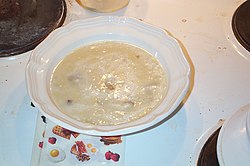Potage

A potage soup prepared with potato and truffle
|
|
| Type | Soup, stew, or porridge |
|---|---|
| Main ingredients | Meat, vegetables |
| |
|
Potage (from Old French pottage; "potted dish"; French pronunciation: [pɔ.taʒ], UK /pɒˈtɑːʒ/, US /poʊˈtɑːʒ/) is a category of thick soups, stews, or porridges, in some of which meat and vegetables are boiled together with water until they form into a thick mush.
Potage has its origins in the medieval cuisine of northern France and increased in popularity from the High Middle Ages onward. A course in a medieval feast often began with one or two potages, which would be followed by roasted meats.
European cottage gardens often contained a variety of crops grown together. These were called potage gardens by the French, as the harvest from that garden was used to make potage.
The earliest known cookery manuscript in the English language, The Forme of Cury, written by the court chefs of King Richard II in 1390, contains several potage recipes including one made from cabbage, ham, onions and leeks. A slightly later manuscript from the 1430s is called Potage Dyvers ("Various Potages"). The word "pottage" is used in the earliest English translations of the Bible, in relation to the lentil soup for which Esau trades his birthright in Genesis 25:29-34; from this story, the phrase "mess of pottage" means something attractive but of little value being exchanged for something much more important. During the Tudor period, a good many English peasants' diets consisted almost solely of potage. Some Tudor-era people ate self-cultivated vegetables like cabbages and carrots and a few were able to supplement this from fruit gardens with fruit trees nearby.
...
Wikipedia
